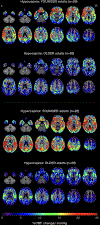Cerebrovascular reactivity deficits in cognitively unimpaired older adults: vasodilatory versus vasoconstrictive responses
- PMID: 35325813
- PMCID: PMC10958374
- DOI: 10.1016/j.neurobiolaging.2022.02.006
Cerebrovascular reactivity deficits in cognitively unimpaired older adults: vasodilatory versus vasoconstrictive responses
Abstract
Cerebrovascular reactivity (CVR) deficits may index vulnerability to vascular brain injury and cognitive impairment, but findings on age-related changes in CVR have been mixed, and no studies to date have directly compared age-related changes in CVR to hypercapnia versus hypocapnia. The present study compared CVR in 31 cognitively unimpaired older adults (ages 55-87) and 30 healthy younger adults (ages 18-28). Breath control tasks induced CVR to hypocapnia (0.1 Hz paced breathing) and hypercapnia (15s breath holds) during pseudo-continuous arterial spin labeling MRI. Relative to younger adults, cognitively unimpaired older adults displayed lower levels of global CVR under both hypocapnia and hypercapnia. In region-of-interest analyses, older adults exhibited attenuated CVR to hypocapnia in select frontal and temporal regions, and lower CVR to hypercapnia in all cortical, limbic, and subcortical regions examined, relative to younger adults. Results indicate age-related deficits in CVR are detectible even in cognitively unimpaired older adults and are disproportionately related to vasodilatory (hypercapnia) responses relative to vasoconstrictive (hypocapnia) responses. Findings may offer means for early detection of cerebrovascular dysfunction.
Keywords: Cerebral blood flow; Cerebrovascular reactivity; Cerebrovascular reserve; Hypercapnia; Hypocapnia; Older adults.
Copyright © 2022. Published by Elsevier Inc.
Conflict of interest statement
Disclosure statement The authors declare that there is no conflict of interest.
Figures



Similar articles
-
Older adults with perivascular spaces exhibit cerebrovascular reactivity deficits.Neuroimage. 2022 Dec 1;264:119746. doi: 10.1016/j.neuroimage.2022.119746. Epub 2022 Nov 9. Neuroimage. 2022. PMID: 36370956 Free PMC article.
-
Comparing cerebrovascular reactivity measured using BOLD and cerebral blood flow MRI: The effect of basal vascular tension on vasodilatory and vasoconstrictive reactivity.Neuroimage. 2015 Apr 15;110:110-23. doi: 10.1016/j.neuroimage.2015.01.050. Epub 2015 Feb 3. Neuroimage. 2015. PMID: 25655446 Free PMC article.
-
Association between cardiorespiratory fitness and cerebrovascular reactivity to a breath-hold stimulus in older adults: influence of aerobic exercise training.J Appl Physiol (1985). 2022 Jun 1;132(6):1468-1479. doi: 10.1152/japplphysiol.00599.2021. Epub 2022 Apr 28. J Appl Physiol (1985). 2022. PMID: 35482329 Free PMC article. Clinical Trial.
-
Magnetic resonance imaging for assessment of cerebrovascular reactivity and its relationship to cognition: a systematic review.BMC Neurosci. 2018 Apr 12;19(1):21. doi: 10.1186/s12868-018-0421-4. BMC Neurosci. 2018. PMID: 29649969 Free PMC article.
-
Cerebrovascular reactivity (CVR) MRI with CO2 challenge: A technical review.Neuroimage. 2019 Feb 15;187:104-115. doi: 10.1016/j.neuroimage.2018.03.047. Epub 2018 Mar 21. Neuroimage. 2019. PMID: 29574034 Free PMC article. Review.
Cited by
-
Older Adults With Smaller and Less Complex Social Networks Show Deficits in Medial Temporal Cerebrovascular Reactivity.J Am Heart Assoc. 2024 Aug 6;13(15):e034390. doi: 10.1161/JAHA.124.034390. Epub 2024 Jul 16. J Am Heart Assoc. 2024. PMID: 39011958 Free PMC article. No abstract available.
-
Nimodipine augments cerebrovascular reactivity in aging but runs the risk of local perfusion reduction in acute cerebral ischemia.Front Aging Neurosci. 2023 Apr 27;15:1175281. doi: 10.3389/fnagi.2023.1175281. eCollection 2023. Front Aging Neurosci. 2023. PMID: 37181624 Free PMC article.
-
Short-term blood pressure variability and brain functional network connectivity in older adults.Neuroimage Rep. 2024 Mar;4(1):100198. doi: 10.1016/j.ynirp.2024.100198. Epub 2024 Feb 14. Neuroimage Rep. 2024. PMID: 38699510 Free PMC article.
-
Spontaneous cerebrovascular reactivity at rest in older adults with and without mild cognitive impairment and memory deficits.medRxiv [Preprint]. 2024 Jun 19:2024.06.18.24309109. doi: 10.1101/2024.06.18.24309109. medRxiv. 2024. Update in: Alzheimers Dement. 2025 Jan;21(1):e14396. doi: 10.1002/alz.14396. PMID: 38946941 Free PMC article. Updated. Preprint.
-
Effects of regional cerebral oxygen saturation monitoring on postoperative cognitive dysfunction in older patients: a systematic review and meta-analysis.BMC Geriatr. 2023 Mar 6;23(1):123. doi: 10.1186/s12877-023-03804-6. BMC Geriatr. 2023. PMID: 36879186 Free PMC article.
References
-
- Bondi MW, Edmonds EC, Jak AJ, Clark LR, Delano-Wood L, McDonald CR, Nation DA, Libon DJ, Au R, Galasko D, Salmon DP, 2014. Neuropsychological criteria for mild cognitive impairment improves diagnostic precision, biomarker associations, and progression rates. J. Alzheimer’s Dis. 42, 275–289. - PMC - PubMed
Publication types
MeSH terms
Grants and funding
LinkOut - more resources
Full Text Sources
Medical

